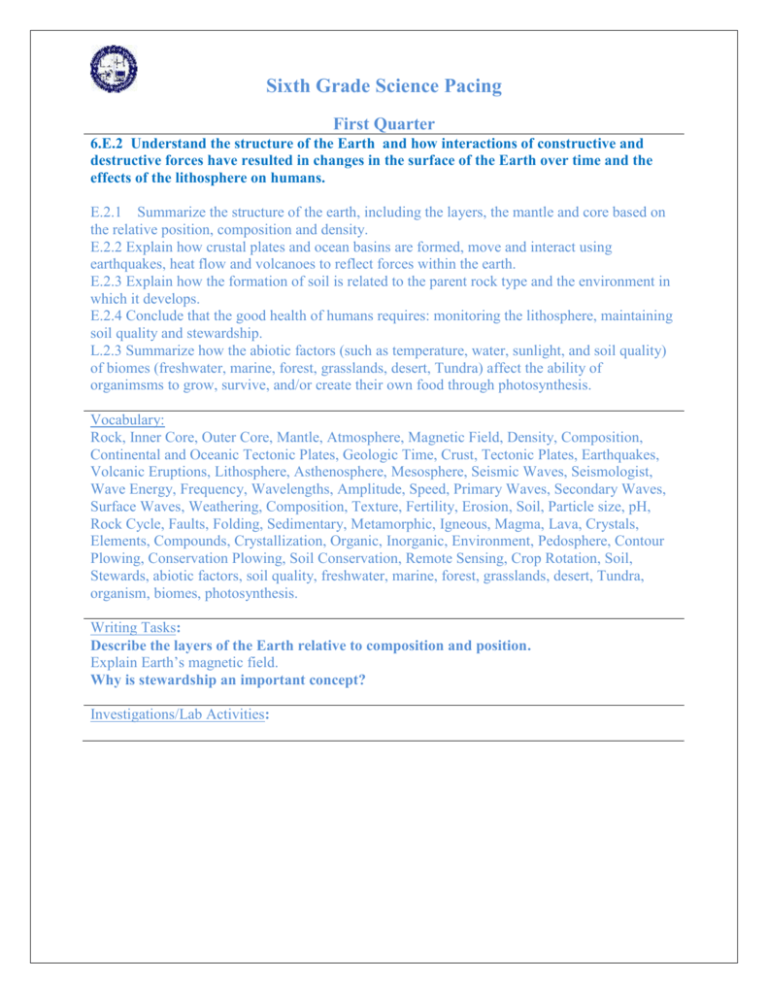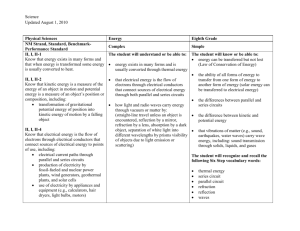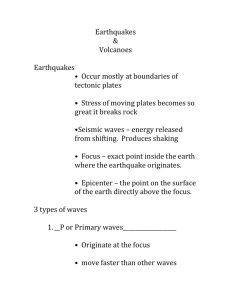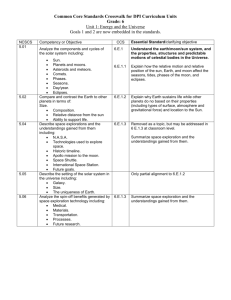Sixth Grade Science Pacing
advertisement

Sixth Grade Science Pacing First Quarter 6.E.2 Understand the structure of the Earth and how interactions of constructive and destructive forces have resulted in changes in the surface of the Earth over time and the effects of the lithosphere on humans. E.2.1 Summarize the structure of the earth, including the layers, the mantle and core based on the relative position, composition and density. E.2.2 Explain how crustal plates and ocean basins are formed, move and interact using earthquakes, heat flow and volcanoes to reflect forces within the earth. E.2.3 Explain how the formation of soil is related to the parent rock type and the environment in which it develops. E.2.4 Conclude that the good health of humans requires: monitoring the lithosphere, maintaining soil quality and stewardship. L.2.3 Summarize how the abiotic factors (such as temperature, water, sunlight, and soil quality) of biomes (freshwater, marine, forest, grasslands, desert, Tundra) affect the ability of organimsms to grow, survive, and/or create their own food through photosynthesis. Vocabulary: Rock, Inner Core, Outer Core, Mantle, Atmosphere, Magnetic Field, Density, Composition, Continental and Oceanic Tectonic Plates, Geologic Time, Crust, Tectonic Plates, Earthquakes, Volcanic Eruptions, Lithosphere, Asthenosphere, Mesosphere, Seismic Waves, Seismologist, Wave Energy, Frequency, Wavelengths, Amplitude, Speed, Primary Waves, Secondary Waves, Surface Waves, Weathering, Composition, Texture, Fertility, Erosion, Soil, Particle size, pH, Rock Cycle, Faults, Folding, Sedimentary, Metamorphic, Igneous, Magma, Lava, Crystals, Elements, Compounds, Crystallization, Organic, Inorganic, Environment, Pedosphere, Contour Plowing, Conservation Plowing, Soil Conservation, Remote Sensing, Crop Rotation, Soil, Stewards, abiotic factors, soil quality, freshwater, marine, forest, grasslands, desert, Tundra, organism, biomes, photosynthesis. Writing Tasks: Describe the layers of the Earth relative to composition and position. Explain Earth’s magnetic field. Why is stewardship an important concept? Investigations/Lab Activities: Sixth Grade Science Pacing Second Quarter 6.E.1 Understand the Earth/moon/Sun system, and the properties, structures and predictable motions of celestial bodies in the Universe. E.1.1 Explain how the relative motion and relative position of the sun, Earth and moon affect the seasons, tides, phases of the moon, and eclipses. E.1.2 Expalin why Earth sustains life while other planets do not based on tier properties (including types of surface, atmosphere nad gravitational force) and location ot the Sun. E.1.3 Summarize space exploration and the understanding gained from them. Vocabulary: Rotation, Revolution, Orbit, Phases, Tides, Satellite, Axis, Law of Universal Gravitation, Solar Eclipse, Lunar Eclipse, Solstice, Equinox, Mass, Weight, Inertia, Gravity, Solar System, Ring, Planets, Meteors, Asteroids, Gravity, Milky Way, Black Hole, Ellipses, Nucleus, Core, Nuclear Fusion, Radiation Zone, Astronomy, Convection Zone, Photosphere, Chromosphere, Corona, Solar Wind, Sunspot, Solar Flare, Gas Giant, UV Light, Meteoroid, Meteorite, Asteroid, Terrestrial Planet, Asteroid Belt, Greenhouse Effect, Light Year, Galaxies, Thrust, Velocity, Space Shuttle, Space Station, Space Probe, Rover, Space Spinoff, Extraterrestrial Life, Planets, Light-year, Probe, ISS, Hubble Telescope Writing Tasks: Explain the relationship of the sun, moon, and Earth in affecting tides, seasons, and phases of the moon. Describe three benefits of the space exploration program over time, and the assess the value of future space exploration. Investigations/Lab Activities: Sixth Grade Science Pacing Third Quarter 6.L.1 Understand the structures, processes and behaviors of plants that enable them to survive and reproduce. L.1.1 Summarize the basic structures and functions of flowering plants required for survival, reproduction, and defense. L.1.2 Explain the significance of the processes of photosynthesis, respiration, and transpiration to the survival of green plants and other organisms. 6.L.2 Understand the flow of energy through ecosystems and the responses of populations to the biotic and abiotic factors in their environment. L.2.1 Summarize how energy derived from the sun is used by plants to produce sugars (photosynthesis) and is transferred within food chains and food webs (terrestrial and aquatic) from producers and consumer to decomposers. L.2.2 Explain how plants respond to external stimuli (including dormancy and forms of tropism) to enhance survival in an environment. Vocabulary: Producers, consumers, decomposers, food chain, food web, molecules, matter, bacteria, nitrogen, energy, nutrients, organisms, sexual reproduction, fertilization, petals, sepals, sterile, stamens, anther, pistils, overy, egg, photosynthesis, glucose, energy, oxygen, carbon dioxide, chlorophyll, cell Writing Tasks: Explain the processes of photosynthesis, respiration, and transportation. Provide evidence to support this statement. The source of all energy is the sun. Describe environmental factors that impact the ability of a plant to survive. Investigations/Lab Activities: Sixth Grade Science Pacing Fourth Quarter 6.P.1 Understand the properties of waves and the wavelike property of energy in earthquakes, light and sound waves. P.1.1 Compare the properties of waves to the wavelike property of energy in earthquakes, light and sound. P.1.2 Explain the relationship among visible light, the electromagnetic spectrum, and sight. P.1.3 Explain the relationship among the rate of vibration, the medium through which vibrations travel, sound and hearing. 6.P.2 Understand the structure, classifications and physical properties of matter. P.2.1 Recognize that all matter is made up of atoms and atoms of the same element are all alike, but are different from the atoms of other elements. P.2.2 Explain the effect of heat on the motion of atoms through a description of what happens to particles during a change in phase. P.2.3 Compare the physical properties of pure substances that are independent of the amount of matter present including density, boiling point, melting point and solubility to properties that are dependent on the amount of matter present to include volume, mass and weight. 6.P.3 Understand characteristics of energy transfer and interactions of matter and energy. P.3.1 Illustrate the transfer of heat energy from warmer objects to cooler ones using examples of conduction, radiation and convection and the effects that may result. P.3.2 Explain the effects of electromagnetic waves on various materials to include absorption, scattering, and change in temperature. P.3.3 Explain the suitability of materials for use in technological design based on a response to heat (to include conduction, expansion, and contraction) and electrical energy (conductors and insulators) Vocabulary: Energy, Thermal Energy, Mechanical energy, Electrical Energy, Electromagnetic Waves, Equilibrium, Conduction, Convection, radiation, Generator Visible Spectrum, Electromagnetic Radiation, Ultraviolet Waves, Refracted, Reflected Thermal Conductors, Thermal Insulators, Electrical Conductor, Electrical Insulator, Nonmetallic Solids Writing Tasks: Explain the characteristics of frequency and amplitude. Explain the structure and function of vocal cords and conditions that affect the sounds they make. Describe what happens to particles during a phase change. Investigations/Lab Activities:







